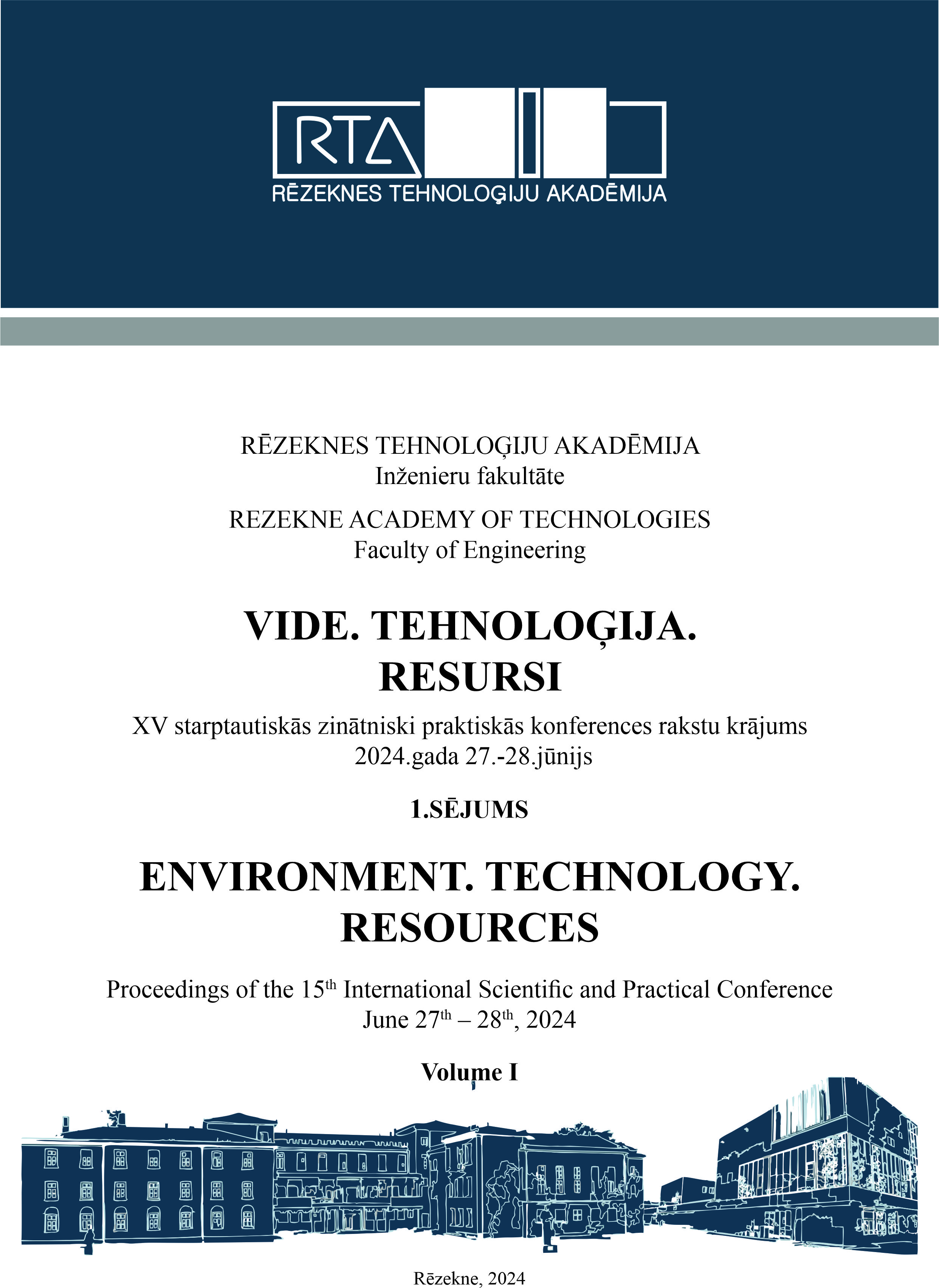CHALLENGES TO THE DEVELOPMENT OF THE MARINE LITTER MONITORING SYSTEM IN BULGARIA
DOI:
https://doi.org/10.17770/etr2024vol1.7975Keywords:
Marine litter, monitoring system, Marine StrategyAbstract
This report presents the results of a study of the development of the marine litter monitoring system in Bulgaria in the period 2016-2022. The system has been structured and operates as part of the implementation of the requirements of the Marine Strategy Framework Directive 2008/56/EC and in particular Descriptor 10 “Marine litter”. Until 2022, the monitoring surveys of the distribution, abundance and accumulation of marine litter were carried out in accordance with specific criteria for macro- and micro-litter. In parallel, the potential sources of marine litter and the pressure of its introduction into the marine environment, beaches, water column and seabed have been analyzed. A comprehensive comparative analysis has been conducted in regards to the applied monitoring procedures, as well as the results of numerous monitoring surveys conducted in the frames of Bulgarian national marine litter monitoring system, during the studied period. As a result the main challenges for the development and the upcoming increase in the scope of the system were identified end presented in this paper. Opportunities to improve the functioning of the system, directed to eliminating weaknesses in relation to used observation protocols, monitoring sites, frequency of monitoring, ensuring representativeness and comparability of monitoring data and information are listed.
Downloads
References
Black Sea Commission, “Marine Litter in the Black Sea Region: A review of the problem”, Black Sea Commission Publications, Istanbul, Turkey, ISBN 978-9944-245-32-6, 2007. [Online]. Available: http://www.blacksea-commission.org/Downloads/Marine_Litter_Report_final.pdf. [Accessed: Feb. 24, 2024].
G20, “Report on Actions Against Marine Plastic Litter”, Fourth Information Sharing based on the G20 Implementation Framework, Ministry of the Environment, Japan, 2022. [Online]. Available: https://g20mpl.org/wp-content/uploads/2022/08/G20MPL-report-2022_2nd-edition_1108.pdf. [Accessed: Feb. 22, 2024].
G20, “Report on Actions Against Marine Plastic Litter”, Fifth Information Sharing based on the G20 Implementation Framework, Ministry of Environment, Forest and Climate Change, New Delhi, India, 2023. [Online]. Available: https://g20mpl.org/wp-content/uploads/2023/07/MPL-report-_2023.pdf [Accessed: Feb. 22, 2024].
United Nations Environment Programme, “Marine Litter: A Global Challenge”, UNEP, Nairobi, ISBN 978-92-807-3029-6, 2009. [Online]. Available: https://www.unep.org/resources/report/marine-litter-global-challenge [Accessed: Feb. 19, 2024].
M. Bergmann, L. Gutow, M. Klages, "Marine Anthropogenic Litter", Springer Link, 2015. [Online]. Available: Springer Nature https://link.springer.com/book/10.1007/978-3-319-16510-3. [Accessed Feb. 24, 2024].
I. Kirstein, S. Kirmizi, A. Wichels, A. Garin-Fernandez, R. Erler, M. Löder, G. Gerdts, "Dangerous hitchhikers, Evidence for potentially pathogenic Vibrio spp. on microplastic particles" Mar Environ Res. 2016 Sep;120:1-8. PMID: 27411093, [Online]. Available: https://pubmed.ncbi.nlm.nih.gov/27411093/. [Accessed Feb. 15, 2024], https://doi.org/10.1016/j.marenvres.2016.07.004
United Nations Environment Programme, “From Pollution to Solution: A global assessment of marine litter and plastic pollution”, UNEP, Nairobi, ISBN: 978-92-807-3881-0, 2021. [Online]. Available: https://www.unep.org/resources/pollution-solution-global-assessment-marine-litter-and-plastic-pollution [Accessed: Feb. 19, 2024].
D. Piazzolla, S. Bonamano, F. De Muto, S. Scanu, S. Bernardini, A. Sodo, G. Della Ventura, M. Marcelli,"Microlitter occurrence, distribution, and summertime transport trajectories in the coastal waters of the north-eastern Tyrrhenian Sea", Geosystems and Geoenvironment, volume 2, issue 4, 100192, ISSN 2772-8838, 2023 [Online]. Available: Science Direct: https://www.sciencedirect.com/science/article/pii/S2772883823000158 [Accessed Feb. 15, 2024], https://doi.org/10.1016/j.geogeo.2023.100192.
European Commission, “Directive 2008/56/EC of the European parliament and of the council of 17 June 2008 establishing a framework for community action in the field of marine environ mental policy (Marine Strategy Framework Directive)”, Off. J. Eur. Union 1–21 (L 164/ 1, 25.6.2008). [Online]. Available: https://eur-lex.europa.eu/legal-content/EN/TXT/?uri=CELEX%3A32008L0056. [Accessed: Feb. 22, 2024].
European Commission, “Commission Decision (EU) 2017/848 of 17 May 2017 laying down criteria and methodological standards on good environmental status of marine waters and specifications and standardised methods for monitoring and assessment, and repealing Decision 2010/477/EU”, Off. J. Eur. Union 1–21 (L 125/43, 18.5.2017). [Online]. Available: https://eur-lex.europa.eu/legal-content/EN/TXT/PDF/?uri=CELEX:32017D0848. [Accessed: Feb. 22, 2024].
A. M. Addamo, P. Laroche, G. Hanke, “Top Marine Beach Litter Items in Europe”, EUR 29249 EN, Publications Office of the European Union, Luxembourg, 2017, ISBN 978-92-79-87711-7, doi:10.2760/496717, JRC108181.
Association Our World, Home page – Black Sea Basin Directorate, 2017 - 2022. [Online]. Available: https://www.bsbd.org/bg/index_bg_8954251.html [Accessed: Feb. 18, 2024].
OSPAR Convention, “Guideline for Monitoring Marine Litter on the Beaches in the OSPAR Maritime Area”, OSPAR, Agreement number 2010-02, ISBN 90 3631 973 9, 2010. [Online]. Available: https://www.ospar.org/documents?v=7260 [Accessed: Feb. 18, 2024].
Joint Research Centre, “Guidance on Monitoring of Marine Litter in European Seas”, Publications Office of the European Union, MSFD Technical Subgroup on Marine Litter (TSG-ML), EUR 26113, 2013, https://doi: 10.2788/99816 [Online]. Available:https://publications.jrc.ec.europa.eu/repository/handle/JRC83985. [Accessed: Feb. 22, 2024].
Joint Research Centre, “A Joint List of Litter Categories for Marine Macrolitter Monitoring”, Publications Office of the European Union, Luxembourg, JRC121708, 2021, https://doi: 10.2760/127473 [Online]. Available: https://publications.jrc.ec.europa.eu/repository/handle/JRC121708 [Accessed: Feb. 23, 2024].
Joint Research Centre, “Guidance on the Monitoring of Marine Litter in European Seas”, Publications Office of the European Union, Luxembourg, ISBN 978-92-76-21445-8, doi:10.2760/127473, JRC133594, 2023, https://doi:10.2760/59137 [Online]. Available: https://mcc.jrc.ec.europa.eu/main/dev.py?N=41&O=466 [Accessed: Feb. 24, 2024].
Black Sea Basin Directorate, Home page – Black Sea Basin Directorate, National Programme on Marine Litter, Descriptor 10 [Online]. Available: https://www.bsbd.org/Marine_env/BLKBG_D10_Marine%20Litter_BG_updated.pdf [Accessed: Feb. 18, 2024].
Black Sea Basin Directorate, Home page – Black Sea Basin Directorate, National report on art.8, 9 and 10, MSFD [Online]. Available: https://cdr.eionet.europa.eu/bg/eu/msfd_art17/2018reporting/textreport/envycqqwa/Second_MSFD_assessment_report_Bulgaria.pdf [Accessed: Feb. 18, 2024]
Downloads
Published
Issue
Section
License
Copyright (c) 2024 Daniela Toneva, Miroslava Robinson

This work is licensed under a Creative Commons Attribution 4.0 International License.



